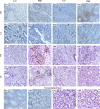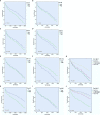Tim3 and PD-1 as a therapeutic and prognostic targets in colorectal cancer: Relationship with sidedness, clinicopathological parameters, and survival
- PMID: 37035199
- PMCID: PMC10076872
- DOI: 10.3389/fonc.2023.1069696
Tim3 and PD-1 as a therapeutic and prognostic targets in colorectal cancer: Relationship with sidedness, clinicopathological parameters, and survival
Abstract
Background: Colorectal cancer (CRC) is a heterogeneous disease that complicates predicting patients' prognosis and their response to treatment. CRC prognosis is influenced by the tumor microenvironment (TME). The immune system is a critical component of the TME. Programmed cell death receptor 1 (PD-1) and T-cell immunoglobulin and mucin-domain containing-3 (Tim3) are inhibitory immune checkpoints that regulate immune response and may provide prognostic power. However, the effect of their expressions and co-expressions on the CRC prognosis remains unclear. Accordingly, this study aimed to investigate the prognostic value of the CD8, CD3, PD-1, Tim3 expression, and PD-1/Tim3 co-expression in patients with CRC.
Materials and methods: One hundred and thirty six patients with CRC who underwent curative surgery were enrolled in the study. Immunohistochemical staining was performed for PD-1, Tim3, CD8, and CD3, and the expression of each marker was evaluated in the center of the tumor (CT), invasive margin (IM), and adjacent normal-like tissue.
Result: Our results indicated that high expression of PD-1 in IM was significantly associated with lower TNM stage, T-stage, M-stage, lack of metastasis, the presence of tertiary lymphoid structure (TLS), lack of recurrence (in the left-sided tumors), and larger tumor size (in right-sided tumors) (P<0.05). High expression of PD-1 in IM was also associated with improved overall survival (OS) in a subgroup of patients with high CD8 expression. High Tim3 expression in CT was associated with higher M-stage (M1) (in left-sided CRCs) (P<0.05). It was also associated with decreased OS in total cohort and left-sided CRCs and represented an independent prognostic factor for CRC patients in multivariate analysis. PD-1 and Tim3 co-expression had no synergistic effects on predicting OS.
Conclusion: Our findings suggest that the clinicopathological and prognostic significance of immune system-related markers such as CD8, PD-1, and Tim3 depends on the primary tumor sides. We also showed that Tim3 could act as a prognostic factor and therapeutic target in CRC. This marker is probably a more preferred target for immunotherapy than PD-1, especially in left-sided CRCs.
Keywords: T cell immunoglobulin and mucin-domain containing-3; colorectal cancer; immune checkpoints; immunotherapy; prognosis; programmed cell death protein-1.
Copyright © 2023 Mokhtari, Rezaei, Sanei, Dehghanian, Faghih, Heidari and Tavana.
Conflict of interest statement
The authors declare that the research was conducted in the absence of any commercial or financial relationships that could be construed as a potential conflict of interest.
Figures



Similar articles
-
A Comprehensive Study on the Prognostic Value and Clinicopathological Significance of Different Immune Checkpoints in Patients With Colorectal Cancer: A Systematic Review and Meta-Analysis.Curr Ther Res Clin Exp. 2024 Sep 12;101:100760. doi: 10.1016/j.curtheres.2024.100760. eCollection 2024. Curr Ther Res Clin Exp. 2024. PMID: 39434898 Free PMC article. Review.
-
Impact of sidedness of colorectal cancer on tumor immunity.PLoS One. 2020 Oct 12;15(10):e0240408. doi: 10.1371/journal.pone.0240408. eCollection 2020. PLoS One. 2020. PMID: 33045001 Free PMC article.
-
Clinicopathological significance and prognostic role of LAG3 + tumor-infiltrating lymphocytes in colorectal cancer; relationship with sidedness.Cancer Cell Int. 2023 Feb 10;23(1):23. doi: 10.1186/s12935-023-02864-3. Cancer Cell Int. 2023. PMID: 36765348 Free PMC article.
-
Increased coexpression of PD-L1 and TIM3/TIGIT is associated with poor overall survival of patients with esophageal squamous cell carcinoma.J Immunother Cancer. 2021 Oct;9(10):e002836. doi: 10.1136/jitc-2021-002836. J Immunother Cancer. 2021. PMID: 34625514 Free PMC article.
-
Predictive Values of Programmed Cell Death-Ligand 1 Expression for Prognosis, Clinicopathological Factors, and Response to Programmed Cell Death-1/Programmed Cell Death-Ligand 1 Inhibitors in Patients With Gynecological Cancers: A Meta-Analysis.Front Oncol. 2021 Feb 1;10:572203. doi: 10.3389/fonc.2020.572203. eCollection 2020. Front Oncol. 2021. PMID: 33634012 Free PMC article.
Cited by
-
Research progress on mechanisms of tumor immune microenvironment and gastrointestinal resistance to immunotherapy: mini review.Front Immunol. 2025 Jul 25;16:1641518. doi: 10.3389/fimmu.2025.1641518. eCollection 2025. Front Immunol. 2025. PMID: 40787471 Free PMC article. Review.
-
Intratumor tertiary lymphatic structure evaluation predicts the prognosis and immunotherapy response of patients with colorectal cancer.Front Immunol. 2024 Mar 1;15:1302903. doi: 10.3389/fimmu.2024.1302903. eCollection 2024. Front Immunol. 2024. PMID: 38500886 Free PMC article.
-
HIV-Helminth Co-Infections and Immune Checkpoints: Implications for Cancer Risk in South Africa.Viruses. 2025 Mar 20;17(3):451. doi: 10.3390/v17030451. Viruses. 2025. PMID: 40143377 Free PMC article.
-
The role of extracellular vesicle immune checkpoints in cancer.Clin Exp Immunol. 2024 May 16;216(3):230-239. doi: 10.1093/cei/uxae026. Clin Exp Immunol. 2024. PMID: 38518192 Free PMC article. Review.
-
A Comprehensive Study on the Prognostic Value and Clinicopathological Significance of Different Immune Checkpoints in Patients With Colorectal Cancer: A Systematic Review and Meta-Analysis.Curr Ther Res Clin Exp. 2024 Sep 12;101:100760. doi: 10.1016/j.curtheres.2024.100760. eCollection 2024. Curr Ther Res Clin Exp. 2024. PMID: 39434898 Free PMC article. Review.
References
LinkOut - more resources
Full Text Sources
Research Materials

